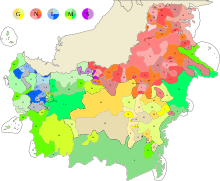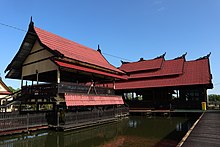You can help expand this article with text translated from the corresponding article in Indonesian. (November 2014) Click for important translation instructions.
|
 Traditional marriage attire of Tidung people, native inhabitants of region around Tana Tidung Regency, North Kalimantan, Indonesia. Traditional marriage attire of Tidung people, native inhabitants of region around Tana Tidung Regency, North Kalimantan, Indonesia. | |
| Total population | |
|---|---|
| 76,000 | |
| Regions with significant populations | |
28,715 (Sabah)
| |
| Languages | |
| Murutic (Nonukan Tidong, Sesayap Tidong, Kalabakan) also Serudung, Indonesian/Malaysian, and English | |
| Religion | |
| Islam | |
| Related ethnic groups | |
| Banjarese, Bakumpai, Bulungan, Kutai, Murut, Lun Bawang/Lundayeh, Paser |
The Tidung, Tidong (Jawi: تيدوڠ) are a native group originating from northeastern part of Borneo and surrounding small islands. They live on both sides of the border of Malaysia and Indonesia.
Tidung speak Tidong language, a North Bornean language. The Tidong are traditionally farmers practising slash-and-burn agriculture. Some are ocean fishermen. They grow sweet potatoes, cassava, lentils, fruits, and vegetables. Their farming methods are often accused of being the main cause of forest fires in Kalimantan.
The rise of the Muslim Tidung Sultanate molded the ethnogenesis character of the Tidung people. They collectively known as a Malayalised Dayak (Indonesian: Dayak berbudaya Melayu or Dayak-Melayu) people of Kalimantan similar to other native Muslim coastal Borneo groups, such as the Bulungan, Kutainese, Banjarese and Paserese people.
Nonetheless, the Tidung people maintain historical connections with the Murut community. Despite following distinct cultural practices, the Tidung and Murut share cultural affinities rooted in their shared histories and interactions within Borneo's diverse ethnic landscape.
Etymology
The term tidung in Tarakan language of the Tidung people literally means "hill" or "hill people". As with many other tribes of the Malay Archipelago, the term tidung is a collective term used to describe many closely related indigenous groups. The different groups of Tidung people describe themselves in all cases as Tidung people, however, they are summarized by modern ethnology as a common people group due to similarities in cultural and religious traditions.
Settlement areas
The traditional territories of the Tidung people are at the Sembakung River, North Kalimantan and Sibuku River of their headwaters to the estuary north of Tarakan Island, Indonesia thence along the coast; south to the river-mouth of Bolongan River and northward up to Tawau, Sabah, Malaysia including Cowie Harbour. An enclave of Tidung people located at Labuk River, opposite the city of Klagan.
Demographics
For Malaysia in the state of Sabah, the census of 2010 (Census 2010) indicates a population of 28,515 Tidong. Whereas, Tidung people in other states have no statistical relevance.
For Indonesia, the population of the Tidung people is estimated about 27,000 in the year of 2007.
Language

The Tidung language spoken by the Tidung people is also part of other Murutic language, which in turn belongs to the Western Malayo-Polynesian languages. The Tidung language is spoken in different dialects, namely:-
- Nonukan, Penchangan, Sedalir, Tikal, Tarakan, Malinau, Sesayap and Sibuku dialect in Indonesia
- Tarakan and Sesayap dialect in Sabah, Malaysia
Writing system
Prior to present-day Roman writing system, the Tidung people used Jawi script in their writings.
Folktales and fables

Among the Tidung folktale includes:
- Asal-usul Orang Tidung Tengara (The origin of Tidung Tenggara people)
- Lasedne sinan pagun (The sink of Jelutong village)
- Seludon Ibenayuk (The tale of Ibenayuk)
- Si Benua dan Si Sumbing (Benua and Sumbing)
- Seludon Yaki Yamus (The tale of Four-eyed king)
- Seludon Batu Tinagad (The logged stone)
- Yaki Balak (The story of Aki Balak)
References
- ^ "Tidong". Joshua Project.
- ^ 2010 Population and Housing Census. Communication from the Statistical Office. 2010.
- ^ M. Paul Lewis (2009). "Summer Institute of Linguistics". Ethnologue: Languages of the World. SIL International. ISBN 978-15-567-1216-6.
- Lewis, M. Paul (2009). "Tidong. A language of Indonesia (Kalimantan)". Ethnologue: Languages of the World, Sixteenth edition. Dallas, Tex.: SIL International. Online version. Archived from the original on 12 August 2011.
- ^ Frank M. LeBar & George N. Appell (1972). Ethnic Groups of Insular Southeast Asia: Indonesia, Andaman Islands, and Madagascar. Human Relations Area Files Press. p. 169. ISBN 08-753-6403-9.
- D.J. Prentice (1970). S.A. Wurm & D.C. Laycock (ed.). The linguistic situation in northern Borneo in: Pacific Linguistic Studies in Honour of Arthur Capell. Pacific Linguistics, Series C.
- "Tidung". ethnologue. Retrieved 4 February 2017.
| Ethnic groups in Sabah | |||||
|---|---|---|---|---|---|
| Sabahan | |||||
| Bumiputera |
| ||||
| Non-Bumiputera | |||||
| Ethnic groups in Malaysia | |||||||||||||||||
|---|---|---|---|---|---|---|---|---|---|---|---|---|---|---|---|---|---|
| Malaysians | |||||||||||||||||
| Bumiputera |
| ||||||||||||||||
| Chinese (list) |
| ||||||||||||||||
| Indian (list) |
| ||||||||||||||||
| Mixed without Bumiputera | |||||||||||||||||
| Foreign ethnicities /expatriates | |||||||||||||||||
| Ethnic groups in Indonesia | |
|---|---|
| Indonesians | |
| Sumatra | |
| Java | |
| Kalimantan | |
| Sulawesi | |
| Papua | |
| Lesser Sunda Islands | |
| Maluku Islands | |
| Non-indigenous | |
| Ethnic groups in the Philippines | |||||||||||||
|---|---|---|---|---|---|---|---|---|---|---|---|---|---|
| Lowland |
| ||||||||||||
| Highland |
| ||||||||||||
| Immigrants or expatriates |
| ||||||||||||